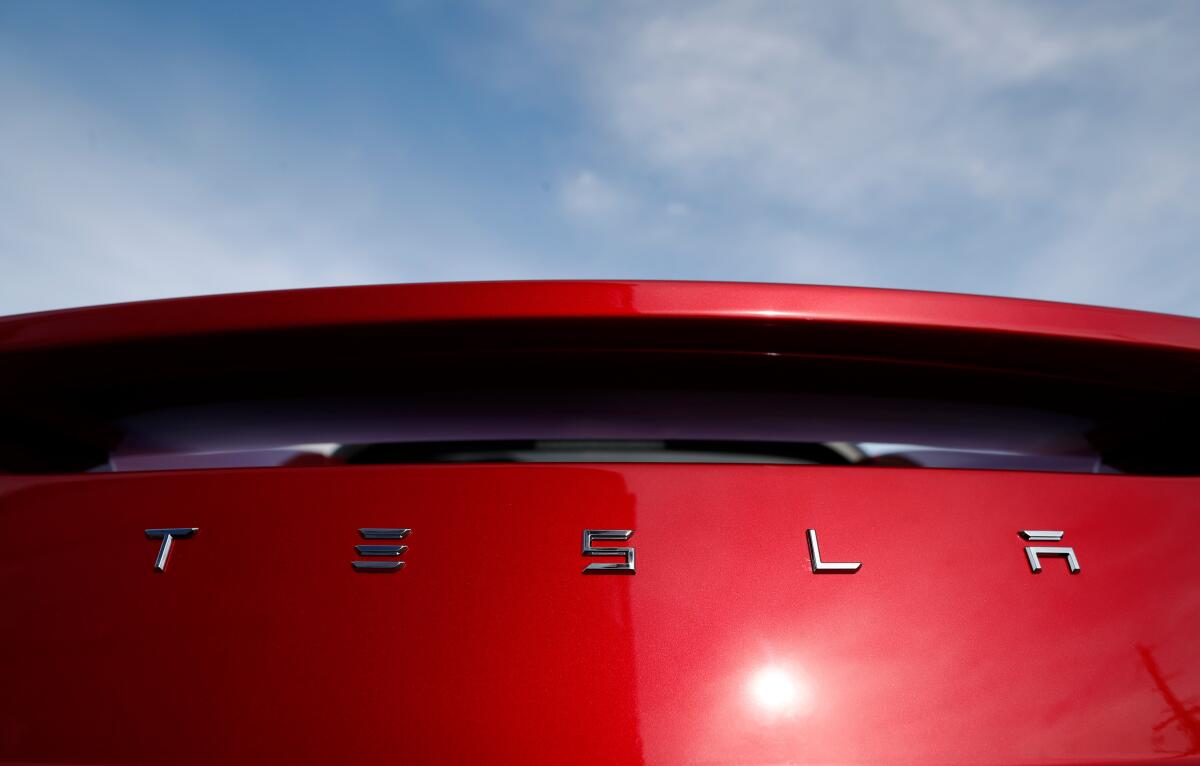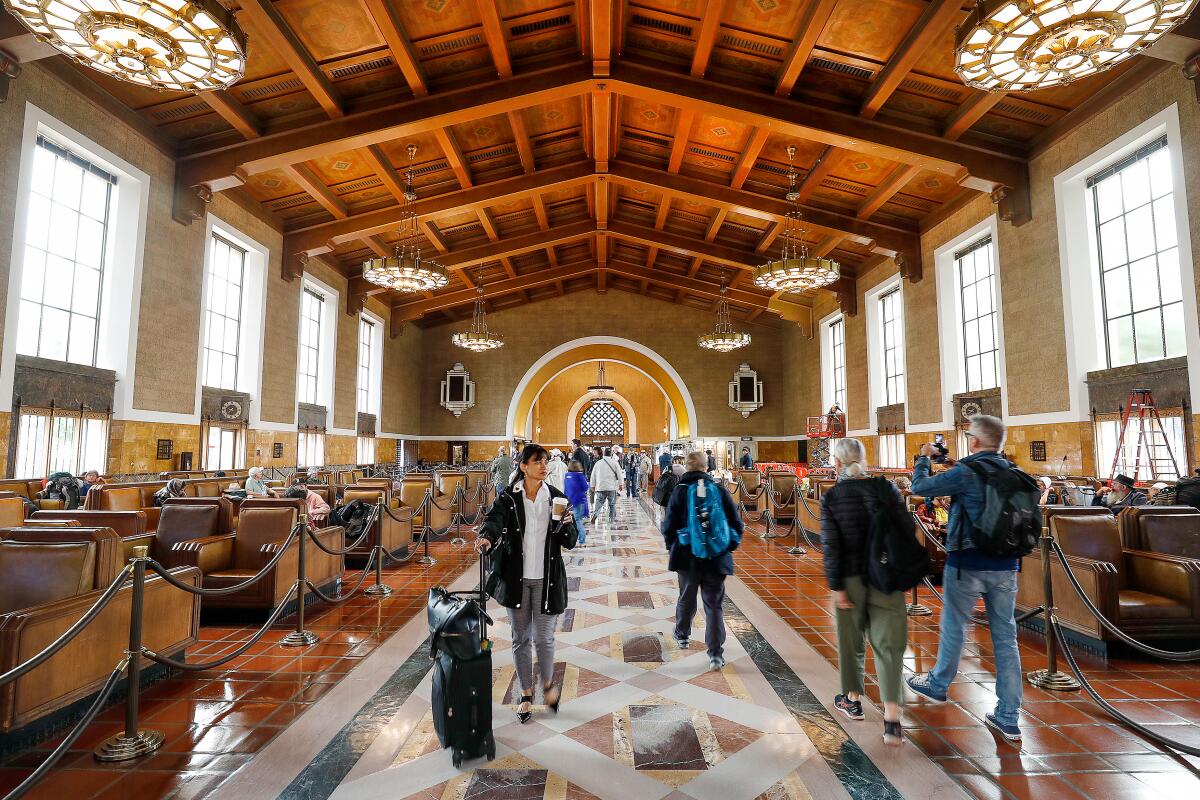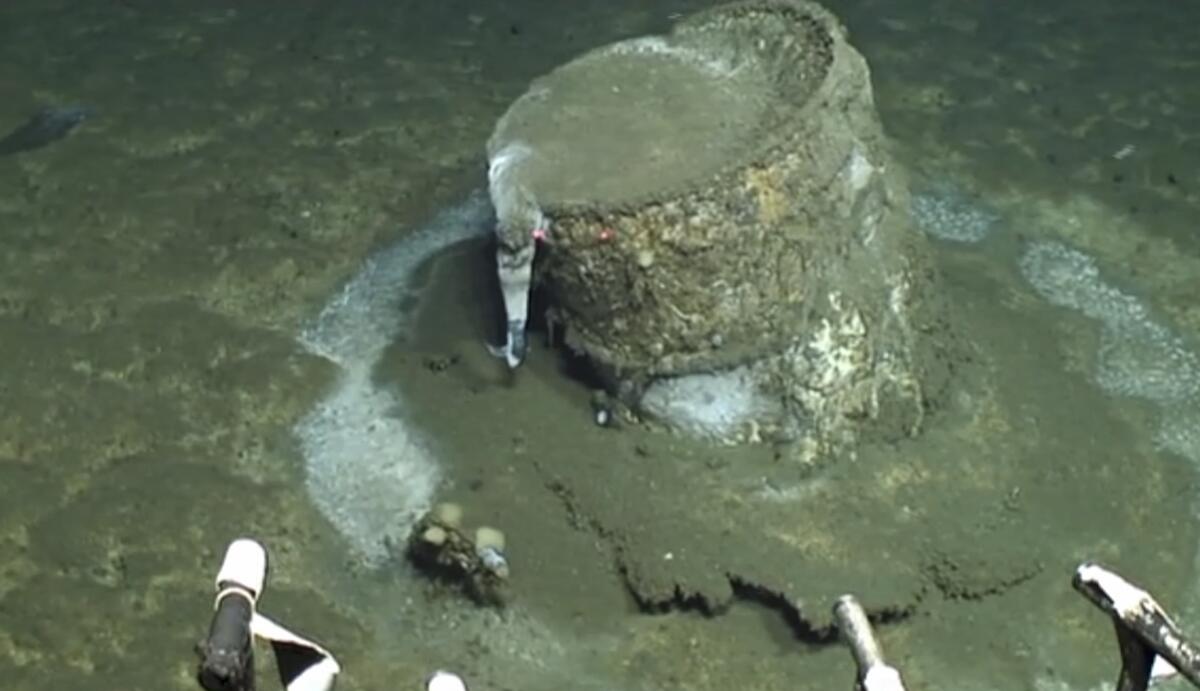Column: Electric vehicle sales slowing down? Don’t panic

- Share via
It’s been a rough few months for electric cars.
Maybe you’ve seen the headlines: falling sales in California, layoffs at electric truck-maker Rivian, cutbacks in production at Ford and GM. And in an election-year concession to autoworker unions, President Biden is reportedly planning to weaken a proposed regulation to transition the U.S. to cleaner vehicles.
On the one hand, oy vey.
On the other hand, keep calm and carry on.
You're reading Boiling Point
Sammy Roth gets you up to speed on climate change, energy and the environment. Sign up to get it in your inbox twice a week.
You may occasionally receive promotional content from the Los Angeles Times.
Cars and trucks are America’s largest source of planet-warming carbon pollution — and I don’t know about you, but I’m scared of what will happen if we don’t get carbon under control. I’ve written about my fears again and again. Heat waves, wildfires, storms, droughts, floods — they’re already plenty bad enough. I don’t want them to get worse.
I also want to live in a world with millions of fewer childhood asthma attacks and hundreds of fewer infant deaths. That would be the result of a widespread transition to electric cars in the U.S., according to a recent report from the American Lung Assn.
So the recent round of negative headlines? They’re not fun.
They’re also no reason to panic.
Partly, that’s because the long-term outlook isn’t as bad as it may seem.
Yes, electric vehicles are still more expensive than their gasoline counterparts. Most of them still don’t go as far on a single charge as we’d like them to, and there still aren’t enough EV charging stations. Hence the falling sales and production cutbacks.
But to quote the comedy troupe Monty Python, those setbacks are most likely “but a flesh wound.” A recent report from research firm Rhodium Group and MIT found that the U.S. is actually adding electric vehicles fast enough to meet President Biden’s aggressive climate goals — even with sales slowing down a bit.
That’s good news. Let’s take a minute to bask in it.
Relative to the slowdown in electric-vehicle sales, I’m more concerned by our seeming inability in modern society — or at least in modern California — to transition quickly away from the personal automobile as the One True Mode of transportation.

As I mentioned a few weeks ago, I’m reading “The Power Broker,” Robert Caro’s 1974 biography of Robert Moses, the bureaucrat who built many of New York’s parks, playgrounds, roads and bridges. I’ve been struck by how many of Caro’s stories are relevant to the climate change era — none more so than the section I read a few days ago about highway expansion.
Three major roadways connecting New York City and Long Island opened in 1936, Caro writes, “bringing to an even one hundred the number of miles of parkway constructed by Moses.” A newspaper editorial “opined that the new parkways would, by relieving the traffic load on [existing parkways], solve the problems of access to Moses’ Long Island parks ‘for generations.’”
Alas, Caro writes, “the new parkways solved the problem for about three weeks.”
There were terrible traffic jams almost immediately — not only on the new roads, but also on existing roads.
Moses’ solution? Build more roads. Which he did, again and again, even as the problem repeated itself, and even as critics began to demand investment in trains as well as roads, which Moses rejected. More space for cars simply induced more driving.
And yet here we are nearly a century later in the nation’s most forward-looking state, still debating whether “induced traffic” is a real thing. It most definitely is, as L.A. Times transportation reporter Rachel Uranga has made extremely clear in her stories. But that hasn’t stopped California from continuing to approve freeway-widening projects that promise to spew air pollution into low-income communities of color — and carbon into the atmosphere — while doing little or nothing to reduce traffic.
Los Angeles Mayor Karen Bass, meanwhile, has refused to take a stance for or against Measure HLA, which would require the city to add hundreds of miles of bike and bus lanes, making it faster and safer to get around without a car. Voters are determining the ballot measure’s fate between now and March 5. Several members of the City Council have endorsed HLA.
Even if we pass the ballot measure and stop widening freeways and drive fewer miles in gasoline cars, the challenge ahead of us is enormous. But strange as it may sound, that’s another reason I’m not too worried about the recent headlines.
The energy transition has already had plenty of ups and downs — and it will almost certainly have many more. Yes, we need start phasing out fossil fuels a lot faster. But we also need to recognize that this transition will not play out in a straight line.
For every two steps forward, there will be a step back. For every big victory, there will be at least one small defeat.
Long term, there’s a lot to be scared about. But short term, let’s focus on the positive. If we let every bad news story get us down, we’ll never have the strength, the courage or the faith we’ll need to rebuild human civilization from the ground up.
It sounds daunting — and it is. But it’s the only way.
Let’s keep our eyes on the prize and charge ahead.
On that note, here’s what’s happening around the West:
TOP STORIES

“The more we look, the more we find, and every new bit of information seems to be scarier than the last.” You know those creepy barrels (see above photo) on the ocean floor off Southern California that my colleague Rosanna Xia has been writing about the last few years? Turns out they may contain radioactive waste, Rosanna writes. Elsewhere in sunny Southern California, the U.S. Environmental Protection Agency has ordered immediate action to protect public health at a burning Los Angeles County landfill, The Times’ Tony Briscoe writes. Residents of the L.A. County city of Torrance, meanwhile, continue to protest the use of the highly toxic chemical hydrofluoric acid to process fuel at the local oil refinery. The refinery says it’s just doing what it has to do to comply with California’s strict emissions standards. Here’s the story from Jaclyn Cosgrove and Irfan Khan.
“Spreading ethereally over the lowest region in North America, the floodwaters reflect mountains that rise around it.” So writes The Times’ Lila Seidman, describing the ghostly lake that formed in Death Valley following recent storms, shallow but deep enough for kayaking. Here’s her story. My colleague Ian James also wrote about the storms, exploring how California went from fears of a snow drought to healthy water supplies. And not that I think regular readers of this newsletter are buying into bonkers conspiracy theories, but please rest assured that cloud seeding by local water agencies is not to blame for the recent downpours, as Salvador Hernandez explains here. Climate change most likely played a role, though.
Several of the top lobbying spenders in the California capitol last year were energy companies or groups, with Chevron in the No. 1 spot. The Western States Petroleum Assn. came in at No. 3, followed by Berkshire Hathaway’s electric utility PacifiCorp at No. 5 and the pro-renewables Energy Foundation at No. 6, per this roundup by CalMatters’ Jeremia Kimelman. And if you were to lump together the state’s biggest utilities — Southern California Edison and Pacific Gas & Electric, plus Southern California Gas and San Diego Gas & Electric parent company Sempra Energy — they’d collectively be near the top of the list too.
POLITICAL CLIMATE
I hadn’t realized that President Obama’s 2016 moratorium on new coal leases on federal lands was still being litigated, so I was surprised to learn that an appeals court just threw it out. Details here from the Associated Press’ Matthew Brown; here’s hoping we’re not still fighting about this one eight years down the road, by which time scientists say we’ll need to have cut carbon emissions nearly in half to avoid the worst consequences of the climate crisis. In other less-than-optimal news for getting carbon under control, the Supreme Court seems inclined to strike down the federal government’s “good neighbor” rule limiting pollution from coal plants and other industrial sources. The Associated Press’ Matthew Daly wrote about the oral arguments.
The Los Angeles County Metropolitan Transportation Authority’s board voted 11-0 to approve the environmental analysis for a gondola to Dodger Stadium. In theory, the gondola would be a win for public transportation, ferrying passengers between downtown L.A.’s Union Station and Dodger Stadium and reducing traffic on game days (which I can say from experience is terrible). But The Times’ Rachel Uranga and Bill Shaikin report that critics are planning to sue, saying the gondola would fuel gentrification in Chinatown and help former Dodgers owner Frank McCourt profit off future development of the Dodger Stadium parking lots, of which he still owns a significant share. At the insistence of L.A. Mayor Karen Bass and her allies, the Metro board’s approval of the gondola was contingent on any future Dodger Stadium parking lot development including affordable housing.
“Global warming is an elemental threat to life on Earth, and ignoring it as its deniers advocate is a recipe for extinction.” So writes L.A. Times columnist Michael Hiltzik, in a piece focused on the $1-million verdict climate scientist Michael Mann just won against two right-wing writers who accused him of fraud. Hiltzik called the verdict “a direct hit on personal attacks on scientists.”
THE ENERGY TRANSITION

The chair of California’s Senate energy committee says climate isn’t his top priority, and we’re moving too fast to change the electric grid. The chair’s name is Steven Bradford, and he’s “cool with natural gas, doesn’t care for net energy metering and is leery of new grid technologies,” per Politico’s Wes Venteicher, who interviewed him. Climate activists must be relieved Bradford is termed out this year, given how fast we need to move on clean energy to meet our climate goals. As Kavya Balaraman reports for Utility Dive, the California Public Utilities Commission just approved a plan that involves building 19 gigawatts of solar, 15.7 gigawatts of four-hour lithium-ion batteries, 2.8 gigawatts of eight-hour batteries, 0.5 gigawatts of long-duration storage and 4.5 gigawatts of offshore wind by 2035. If those sound like big numbers, that’s because they are.
Do solar panels dream of shaded sheep? If you’ll forgive the silly literary allusion — it’s supposed to be a reference to the Philip K. Dick novel, “Do Androids Dream of Electric Sheep?” which inspired the film “Blade Runner” — I very much enjoyed this hopeful story by Jake Bolster for Inside Climate News, about the potential for sheep to graze under solar panels at a planned solar project in Wyoming. If we could do more of this “agrivoltaics” thing across the American West, it would make moving away from coal, oil and fossil natural gas a lot easier. Less conflict over land use would mean more renewable energy development more quickly.
It’s the end of an era in the Pacific Northwest’s Columbia River Basin, with the Biden administration and Native American tribes striking a water management deal that does not include the removal of four dams on the Lower Snake River. Details here from the Seattle Times’ Isabella Breda, who writes that the tribes “will help restore wild fish and lead in the construction of at least 1 to 3 gigawatts of clean-energy” — potentially allowing the dams to come down later. Near the California-Oregon state line, meanwhile, four dams on the Klamath River are being demolished — and the draining of the reservoirs behind those dams could lead to thousands of acres of new land for the Shasta Indian Nation, the San Francisco Chronicle’s Kurtis Alexander reports.
AROUND THE WEST
The liquefied natural gas export terminals being proposed along America’s Gulf Coast are getting a lot of attention — and rightly so, considering the possible climate consequences. But there’s another export boom underway to send U.S. gas to Asia via Mexico’s Pacific Coast, as the New York Times’ Max Bearak explores in this story. One of the firms investing in the Mexico route is Sempra Energy, parent company of Southern California Gas Co. and San Diego Gas & Electric, as I’ve written previously.
A new study finds that California’s system for setting aside money for disadvantaged communities has all sorts of biases built into it and could leave out some low-income communities of color that deserve funding. On the one hand, this is not at all surprising — no formula was ever going to capture every health condition, historical injustice and environmental inequity that we can and should be trying to take into account. On the other hand, I’m glad someone did a study and quantified some of the shortcomings, and I hope state officials take them seriously. Details here from CalMatters’ Alejandro Lazo.
An in-depth investigation by Mark Olalde and Nick Bowlin, co-published by ProPublica and Capital & Main, estimates just how many billions of dollars fossil fuel companies have failed to set aside to plug oil and gas wells at the end of their lives, probably leaving taxpayers to foot the bill. (Spoiler alert: It’s a lot of billions.) Here’s the story, in all its inglorious detail. In another so-wild-it’s-almost-hard-to-believe investigation, the Washington Post’s Evan Halper wrote about school districts that are letting a group backed by fossil fuel companies teach high school students that plastics are actually great.
ONE MORE THING

Oh, the delicate needle to be threaded between climate-conscious consumerism and not consuming so damn much.
I knew when I wrote a few weeks ago about the need for more electric vehicle advertisements at the Super Bowl that I would get some unhappy emails about how the key to fighting the climate crisis is to stop driving so much, stop using so much energy, stop reveling in capitalism. And indeed I did. How could I not understand that consumerism was to blame for our climate woes?
There’s value in that question. I was grateful to see Heated newsletter authors Emily Atkin and Arielle Samuelson grapple with it in this edition of their excellent newsletter, headlined, “There’s no such thing as a ‘climate-friendly’ Super Bowl.”
“Don’t let the excitement of a 100 percent renewable-powered stadium drive you into a state of delusion about what’s actually happening,” they wrote. “The Super Bowl is still a massive climate pollution event. For it to become truly ‘climate-friendly’ — aka, not adding any emissions into the atmosphere — it will have to change in ways that most people are not ready to think about.”
They’re right. We need to consume less, refashion our daily habits, maybe ask sports leagues to rework their schedules.
We also need to accept, as I’ve argued previously, that our best shot at avoiding truly devastating climate consequences — while maintaining as much as we can of the quality of life we’ve come to enjoy in the developed world, and while extending that quality of life to those not yet lucky enough to enjoy it — involves building a huge amount of clean energy infrastructure.
Solar farms, not gas export terminals. High-speed rail, not freeways. Learn the right lessons from Robert Moses.
Everything in balance.
This column is the latest edition of Boiling Point, an email newsletter about climate change and the environment in California and the American West. You can sign up for Boiling Point here. And for more climate and environment news, follow @Sammy_Roth on X.
Toward a more sustainable California
Get Boiling Point, our newsletter exploring climate change, energy and the environment, and become part of the conversation — and the solution.
You may occasionally receive promotional content from the Los Angeles Times.




